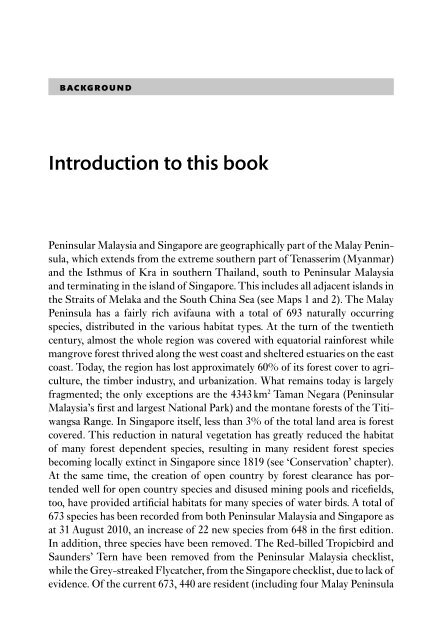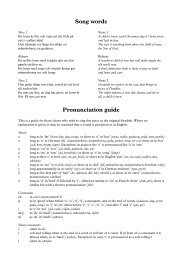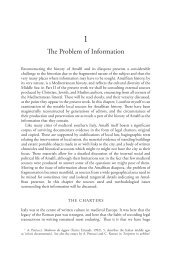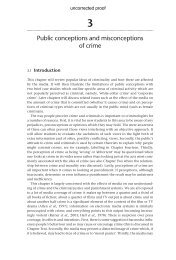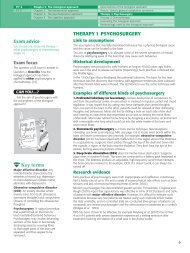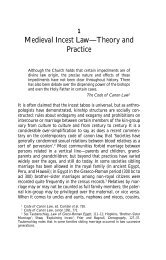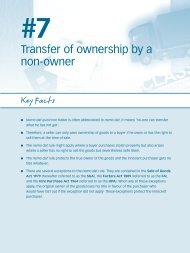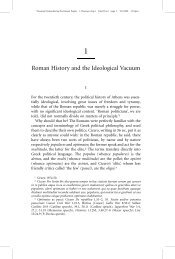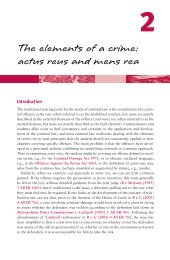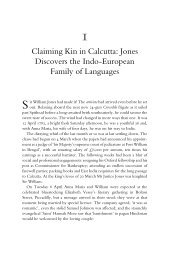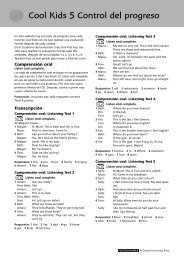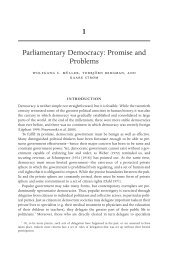Introduction to this book
Introduction to this book
Introduction to this book
Create successful ePaper yourself
Turn your PDF publications into a flip-book with our unique Google optimized e-Paper software.
ackground<br />
<strong>Introduction</strong> <strong>to</strong> <strong>this</strong> <strong>book</strong><br />
Peninsular Malaysia and Singapore are geographically part of the Malay Peninsula,<br />
which extends from the extreme southern part of Tenasserim (Myanmar)<br />
and the Isthmus of Kra in southern Thailand, south <strong>to</strong> Peninsular Malaysia<br />
and terminating in the island of Singapore. This includes all adjacent islands in<br />
the Straits of Melaka and the South China Sea (see Maps 1 and 2). The Malay<br />
Peninsula has a fairly rich avifauna with a <strong>to</strong>tal of 693 naturally occurring<br />
species, distributed in the various habitat types. At the turn of the twentieth<br />
century, almost the whole region was covered with equa<strong>to</strong>rial rainforest while<br />
mangrove forest thrived along the west coast and sheltered estuaries on the east<br />
coast. Today, the region has lost approximately 60% of its forest cover <strong>to</strong> agriculture,<br />
the timber industry, and urbanization. What remains <strong>to</strong>day is largely<br />
fragmented; the only exceptions are the 4343 km 2 Taman Negara (Peninsular<br />
Malaysia’s fi rst and largest National Park) and the montane forests of the Titiwangsa<br />
Range. In Singapore itself, less than 3% of the <strong>to</strong>tal land area is forest<br />
covered. This reduction in natural vegetation has greatly reduced the habitat<br />
of many forest dependent species, resulting in many resident forest species<br />
becoming locally extinct in Singapore since 1819 (see ‘Conservation’ chapter).<br />
At the same time, the creation of open country by forest clearance has portended<br />
well for open country species and disused mining pools and ricefi elds,<br />
<strong>to</strong>o, have provided artifi cial habitats for many species of water birds. A <strong>to</strong>tal of<br />
673 species has been recorded from both Peninsular Malaysia and Singapore as<br />
at 31 August 2010, an increase of 22 new species from 648 in the fi rst edition.<br />
In addition, three species have been removed. The Red-billed Tropicbird and<br />
Saunders’ Tern have been removed from the Peninsular Malaysia checklist,<br />
while the Grey-streaked Flycatcher, from the Singapore checklist, due <strong>to</strong> lack of<br />
evidence. Of the current 673, 440 are resident (including four Malay Peninsula
2 Background<br />
endemics, 165 migrants, 50 vagrants, 14 feral species, and four species which<br />
have become locally extinct). This <strong>to</strong>tal is based on four published sources,<br />
namely The Birds of the Thai-Malay Peninsula Volumes One (Non-Passerines,<br />
published 1999, hereafter referred <strong>to</strong> as W1), and Two (Passerines, published<br />
2007, W2) by David. R. Wells, An Annotated Checklist of the Birds of Singapore<br />
by Wang Luen Keng and Chris<strong>to</strong>pher Hails, published in 2007 (W and H),<br />
A Checklist of the Birds of Peninsular Malaysia, published in 2010 (MNS-Bird<br />
Conservation Council), and both published and unpublished reports of the<br />
Malaysian Nature Society Bird Conservation Council Records Committee,<br />
from 2009–2010. Note: the <strong>to</strong>tal number of resident species also includes 36<br />
species which have migra<strong>to</strong>ry populations from higher latitudes; the latter will<br />
not be included under regular migrants, rare migrants, and vagrants which will<br />
comprise only true migrants which do not have resident populations.<br />
A brief his<strong>to</strong>ry of ornithology in both Peninsular<br />
Malaysia and Singapore<br />
The current checklists of the birds of both Peninsular Malaysia and Singapore<br />
are the results of accumulated research based on collected specimens<br />
and observations by pioneer collec<strong>to</strong>rs, researchers, and birdwatchers in <strong>this</strong><br />
region from the early nineteenth century until 2010. When Stamford Raffl es<br />
established British infl uence in Singapore in 1819, he under<strong>to</strong>ok the task of<br />
collecting of zoological specimens for the British Museum. Being a keen zoologist<br />
himself, Raffl es had previously collected specimens in Java and Sumatra<br />
and was responsible for describing some of the birds which were then new <strong>to</strong><br />
science; some notable examples being Raffl es’s Malkoha, Red-naped Trogon,<br />
Black-and-Yellow Broadbill, and Little Green-broadbill (Green Broadbill).<br />
Other notable collec<strong>to</strong>rs who worked in Singapore in the nineteenth century<br />
include Alfred Russel Wallace, A.O. Hume, and H.R. Kelham. H.N. Ridley,<br />
the father of Malaysia’s rubber industry, also contributed greatly in the form<br />
of personal observations.<br />
Although there was a fair trade in bird skins through Melaka in the early<br />
nineteenth century, collecting expeditions in Peninsular Malaysia (then<br />
Malaya) by Europeans did not begin until the late nineteenth century when the<br />
British established and consolidated their infl uence in Malaya in 1874 after the<br />
signing of the Pangkor Treaty. Collec<strong>to</strong>rs ventured in<strong>to</strong> the interior <strong>to</strong> obtain<br />
specimens for museums. Among some of the collec<strong>to</strong>rs in the early twentieth<br />
century were J. Waterstradt, H.C. Robinson, C.B. Kloss, F.N. Chasen, and later<br />
C.A. Gibson-Hill. All specimens collected were prepared as skins and deposited<br />
both at the British Museum (Natural His<strong>to</strong>ry) and the Raffl es Museum in
PULAU<br />
LANGKAWI<br />
PERLIS<br />
PULAU<br />
PINANG<br />
Kuala Gula<br />
Alor Setar<br />
K E D A H<br />
Muda<br />
Land over 500 metres<br />
Perak<br />
P E R A K<br />
S E L A N G O R<br />
Kuala Selangor<br />
Map 1 Peninsular Malaysia.<br />
Galas<br />
S t r a i t s o f M e l a k a<br />
0 50 100 miles<br />
0<br />
80 160 km<br />
Kelang<br />
Kuala<br />
Lumpur<br />
<strong>Introduction</strong> <strong>to</strong> <strong>this</strong> <strong>book</strong> 3<br />
Singapore. Robinson and Chasen in particular were instrumental in making<br />
detailed descriptions of ornithological specimens collected and published their<br />
work in four volumes between 1927 and 1939. This excellent series, The Birds<br />
of the Malay Peninsula, though out of date, still remains as a major standard<br />
reference work on ornithology in <strong>this</strong> region.<br />
Lebir<br />
K E L A N T A N<br />
Langat<br />
Kota Bharu<br />
P A H A N G<br />
N E G E R I<br />
Rompin<br />
S O U T H<br />
C H I N A<br />
S E A<br />
Kuala Terengganu<br />
T E R E N G G A N U<br />
Kuantan<br />
Pekan<br />
S E M B I L A N<br />
Port<br />
Dickson<br />
MELAKA<br />
Melaka J O H O R<br />
Muar<br />
Batu Pahat<br />
Johor Baharu<br />
SINGA-<br />
PORE<br />
100˚ 102˚ 104˚<br />
Kelantan<br />
Tembeling<br />
Teriang<br />
Pahang<br />
Endau<br />
Johor<br />
6˚<br />
4˚<br />
PULAU<br />
TIOMAN<br />
2˚
4 Background<br />
Map 2 Singapore.
<strong>Introduction</strong> <strong>to</strong> <strong>this</strong> <strong>book</strong> 5
6 Background<br />
The formation of the Malayan Nature Society (MNS) (now the Malaysian<br />
Nature Society) in July 1940 was a great boost <strong>to</strong> conservation in Peninsular<br />
Malaysia and Singapore. Its publication, The Malayan Nature Journal, is a good<br />
source of information on birds especially on behavioural observations as well<br />
as birdwatching localities. Most of all it provided a forum for ornithologists<br />
and birdwatchers in <strong>this</strong> region <strong>to</strong> discuss and share their pooled knowledge.<br />
Among them were G.C. Madoc, A.T. Edgar James Cairns, and E.H. Bromley.<br />
F.G.H. Allen, B.D. Molesworth, and Loke Wan Tho also contributed greatly<br />
besides being the pioneers of bird pho<strong>to</strong>graphy in <strong>this</strong> region. The Singapore<br />
Branch of the MNS was formed in 1954.<br />
The 1960s saw the study of birds in Malaya shift <strong>to</strong> a more scientifi c<br />
approach. This involved extensive ringing of migra<strong>to</strong>ry birds by the Migra<strong>to</strong>ry<br />
Animal Pathological Survey (MAPS) programme and the University of<br />
Malaya Bird Ringing Project (UMBRP) (see ‘Migration’ chapter for details).<br />
Scientifi c data were collated from studies by Lord Medway (now the Earl of<br />
Cranbrook), H. Elliot McClure, I.C.T. Nisbet, and David R. Wells. Since 1963,<br />
the Malayan Nature Journal has published an annual bird report, making it a<br />
valuable source of reference, especially on current updates. A successful expedition<br />
<strong>to</strong> Gunung Benom (Pahang) by the University of Malaya and the British<br />
Museum (Natural His<strong>to</strong>ry) in 1967 yielded vital information on the altitudinal<br />
distribution of some of the species of birds there.<br />
The increasing numbers of skilled and reliable observers from both Peninsular<br />
Malaysia and Singapore from the late 1960s until the present time have<br />
contributed signifi cantly <strong>to</strong> ornithology and conservation in both countries.<br />
Notable among them are Dennis Yong Ghong Chong, Geoffrey W.H. Davison,<br />
Lim Kim Seng, Lim Kim Chuah, Mike H.N. Chong, Chacko Kurian,<br />
Ho Hua Chew, Chris<strong>to</strong>pher J. Hails, John Duckett, Glenda Noramly, Mano<br />
Tharmalingam, Frank Lambert, John Howes, Crawford Prentice, Taej Mundkur,<br />
Lim Kim Chye, Lim Swee Yian, Yang Chong, Choo Jin Wah, Theresa<br />
Ong, Wang Luan Keng. Kanda Kumar Doraisamy, Subaraj Rajathurai, David<br />
Bakewell, Ooi Beng Yean, Chiu Sein Chiong, Ooi Chin Hock, the late Laurence<br />
Poh Soon Pin, Michael S.N. Godfrey, Lian Godfrey, Clive Briffett,<br />
Lim Aun Tiah, Anthony C. Sebastian, Sutari Supari, Dr. Neoh Chin Boon,<br />
Neoh Hor Kee, Peter Kennerly, Morten Strange, Mah Teck Oon, Andrew<br />
J. Sebastian, Nazeri Abghani, Yeap Chin Aik, Melinda Tan, David Lai, Nina<br />
Cheung, Khoo Swee Seng, Caroline Ho, Mohamed Rafi Abdul Kudus, Angela<br />
Rafi Francombe, Anuar McAfee, Ravinder Kaur, Diya Rashidah Abu Rahman,<br />
Eileen Chiang, John and Jasmine Steed, Wilbur Goh, Alan Owyong, and<br />
Sunny Yeoh. Personnel of Peninsular Malaysia’s Department of Wildlife and
<strong>Introduction</strong> <strong>to</strong> <strong>this</strong> <strong>book</strong> 7<br />
National Parks who conducted signifi cant research and shared new information<br />
include Louis Ratnam, Abdul Rahman Ismail, and Siti Hawa Yatim.<br />
By and large, there have been many new sightings and published literature.<br />
New species have been added on<strong>to</strong> the list. The Mountain Hawk-eagle<br />
was only confi rmed as a breeding resident on Pulau Langkawi in 2002 while<br />
the Short-tailed Shearwater and Dark-throated Thrush were added on<strong>to</strong> the<br />
Peninsular Malaysia checklist in 2010. Singapore being much smaller in area<br />
has been thoroughly covered by her pool of reliable observers and most birds<br />
there have been relatively well documented. Latest additions <strong>to</strong> the Singapore<br />
checklist include the Lesser Kestrel in 2001 and the Oriental Hobby in 2002.<br />
The formation of Interwader (later Asian Wetland Bureau and now Wetlands<br />
International) in 1983 has contributed signifi cantly <strong>to</strong> the study of shorebirds<br />
as well as other aquatic birds in <strong>this</strong> region. Wetlands International conducts an<br />
annual waterfowl census in January every year, and observers from both Malaysia<br />
and Singapore regularly participate and <strong>this</strong> has yielded valuable information<br />
on especially migra<strong>to</strong>ry waterfowl and their habitats.<br />
Both the Selangor and Singapore Branches of MNS had a bird study<br />
group each. These bird study groups organized numerous fi eld trips as well<br />
as indoor talks and slide shows <strong>to</strong> boost enthusiasm. The Singapore Branch<br />
Bird Study Group was renamed the Singapore Bird Group in 1986 and publishes<br />
a regular ornithological bulletin, Singapore Avifauna, which publishes<br />
latest sightings, behavioural observations, and updates information in both<br />
Singapore and the Peninsular Malaysian state of Johor. It maintains a Records<br />
Committee <strong>to</strong> verify and record sightings in Singapore. The Selangor Branch<br />
Bird Group used <strong>to</strong> cover the whole of Peninsular Malaysia and used <strong>to</strong> publish<br />
a monthly ornithological bulletin, Enggang from January 1988 <strong>to</strong> June<br />
1990. It had the same objectives of Singapore Avifauna. Due <strong>to</strong> unforeseen<br />
circumstances, Enggang ceased publication in 1990. The MNS Selangor Bird<br />
Group has been instrumental in helping <strong>to</strong> compile the bird lists during the<br />
Endau-Rompin expeditions of 1985 and 1989 and later the Belum Expedition<br />
in 1993. It also helps <strong>to</strong> update sightings of birds in the Kuala Selangor<br />
Nature Park which was established in 1987 and managed by MNS and the<br />
Selangor State Government.<br />
The Singapore Branch broke away from the MNS in 1991 and became the<br />
Nature Society (Singapore) (NSS). Today, it is the authority on bird conservation<br />
in Singapore. In 1995 the MNS Bird Conservation Council (MNS-BCC)<br />
was formed primarily <strong>to</strong> help in the conservation of key habitats in the country<br />
besides identifying potentially threatened species. A Records Committee was<br />
formed <strong>to</strong> update and oversee new sightings for Malaysia (including Sarawak
8 Background<br />
and Sabah). When MNS and BirdLife International (formerly International<br />
Council for Bird Preservation) became partners in 1995, the Bird Conservation<br />
Council was given the task of coordinating and updating information on<br />
endangered species in Malaysia in efforts <strong>to</strong> identify potentially threatened<br />
species <strong>to</strong> be included in the Red Data Book of BirdLife International. The<br />
NSS is also a partner of BirdLife International and performs the same task<br />
as MNS in <strong>this</strong> capacity. Enggang was revived in 1996 under the new title of<br />
Suara Enggang and continues <strong>to</strong> be a regular publication of the MNS-BCC.<br />
Since 2005, it has taken a new look with full-colour front and back covers and<br />
in 2011, will be in full colour on the same lines as established international<br />
birdwatching periodicals, thanks <strong>to</strong> generous funding from Schmidt Marketing<br />
(Malaysia) Sdn Bhd.<br />
Being partners of BirdLife International, both the MNS and the NSS were<br />
actively involved in the Important Bird Area Programme (IBA) which was<br />
launched in 1996. This involved identifying key bird habitats within Malaysia<br />
and Singapore, documenting them, and working <strong>to</strong>wards their conservation<br />
and sustainable management. This also involved working closely with<br />
the relevant governmental and non-governmental agencies in both countries<br />
<strong>to</strong> ensure that conservation goals are realized. A <strong>to</strong>tal of 18 IBAs was identifi<br />
ed in Peninsular Malaysia and three in Singapore, their documentation is<br />
published in BirdLife’s publication Important Bird Areas in Asia: Key sites<br />
for conservation (2004). Read <strong>this</strong> publication for details. The annual Rap<strong>to</strong>r<br />
Watch, fi rst started in 2000, is another important project of the MNS-BCC.<br />
The objectives are <strong>to</strong> educate the public on rap<strong>to</strong>r migration and conservation<br />
as well as <strong>to</strong> highlight the importance of the Tanjung Tuan Forest Reserve as<br />
an important conservation area.<br />
In Singapore, the Bird Ecology Study Group was formed in 2005 by<br />
Dr. Wee Yeow Chin, Subaraj Rajathurai, and Richard Hale. This group leads<br />
birdwatchers <strong>to</strong> study the behaviour of birds and document their interaction<br />
with the environment and other animals in a more systematic way. Sightings,<br />
breeding records, and behavioural observations are readily made available<br />
through its blog. Since March 2008, Malaysia has been part of Worldbirds global<br />
family of internet-based data collection and provision systems <strong>to</strong> capture<br />
bird records. Known as Bird I Witness Malaysia (BiW), it is managed by MNS<br />
and has an administra<strong>to</strong>r. Its task will be <strong>to</strong> validate and collate collected data<br />
with the objective that such data can be used <strong>to</strong> effect conservation of birds and<br />
biodiversity. Local and visiting birdwatchers and scientists can register and<br />
participate in <strong>this</strong> project by recording all their personal observations which<br />
can then be made available <strong>to</strong> others. This project forms an invaluable database
<strong>Introduction</strong> <strong>to</strong> <strong>this</strong> <strong>book</strong> 9<br />
for all birds recorded in Peninsular Malaysia, Sabah, and Sarawak. Many new<br />
updates in <strong>this</strong> edition have been extracted from BiW.<br />
The basis of <strong>this</strong> <strong>book</strong><br />
The aim of <strong>this</strong> <strong>book</strong> is <strong>to</strong> systematically identify all birds which occur in Peninsular<br />
Malaysia and Singapore as well as provide information on the status and<br />
distribution of every species in both countries. The unit of measurement used<br />
in <strong>this</strong> <strong>book</strong> is the metric system with the lengths of birds given in centimetres<br />
(cm). All elevations and heights are stated in metres (m) while distances are<br />
given in kilometres (km). Sibley and Monroe’s Distribution and taxonomy of<br />
birds of the world, fi rst published in 1990 and revised in 1993 reclassify bird<br />
families and genera based on DNA-hybridization studies. In the fi rst edition,<br />
the classifi cation of bird families in <strong>this</strong> <strong>book</strong> was based on Peter’s Sequence<br />
which birdwatchers and fi eld ornithologists were more familiar with then. In<br />
<strong>this</strong> second edition, we have opted <strong>to</strong> follow largely The Howard and Moore<br />
Complete Checklist of the Birds of the World 3rd edition (Dickinson, 2003).<br />
The taxonomic classifi cation in <strong>this</strong> checklist follows the latest fi ndings based<br />
largely on DNA-hybridization, and for the review area, begins with the family<br />
Phasianidae (Partridges, Quail, and Pheasants), and ends with the family<br />
Emberizidae (Buntings). Where appropriate we also follow The Birds of the<br />
Thai-Malay Peninsula Volumes One (non-passerines; W1) and Two (passerines;<br />
W2) as these are the two main authoritative sources for the review area.<br />
Splits followed by Robson (2008) will only be adopted where evidence justifying<br />
the splits is clear.<br />
Family and species descriptions<br />
The family and species description begins with the general introduction <strong>to</strong><br />
each bird family and a short account of its general characteristics and habits.<br />
It also gives the <strong>to</strong>tal numbers of species in the world, followed by the <strong>to</strong>tal<br />
number in the review area. For <strong>this</strong> purpose, the world <strong>to</strong>tals follow Howard<br />
and Moore 3.<br />
A detailed treatment of each group and genera within most families is also<br />
given <strong>to</strong> show diversity, e.g. the family Ardeidae (Herons, Egrets, and Bitterns)<br />
is divided in<strong>to</strong> six distinct groups and 12 genera. This is <strong>to</strong> familiarize the<br />
reader with the different groups <strong>to</strong> aid in quicker identifi cation.<br />
Species numbers<br />
Each species is given a number in the main text, which is also indicated on<br />
the colour plates and caption pages for quick and easy reference. The species
10 Background<br />
number is maintained throughout the main text when it is mentioned in relation<br />
<strong>to</strong> another species. This is <strong>to</strong> facilitate quick cross reference. When a bird<br />
family is mentioned, the whole species sequence within the family is given,<br />
e.g. s<strong>to</strong>rks (34–39). Likewise when a genus is mentioned, the whole species<br />
sequence within the genus is given, e.g. genus Mycteria (34, 35). When a subspecies<br />
of a species is still under review, pending elevation <strong>to</strong> species rank, it<br />
is indicated by a decimal number in the species account and on the plate and<br />
caption page, e.g. White-faced Plover, 146.1 because it is described in relation<br />
with the Kentish Plover which is number 146. Similarly when a hybrid occurs<br />
in the wild, it is also indicated by a decimal number. The Upland Buzzard x<br />
Long-legged Buzzard hybrid is given the number 108.1, because it is mentioned<br />
immediately after the Common Buzzard, which is number 108, as both<br />
belong <strong>to</strong> the same genus, Buteo. Neither the Upland nor Long-legged Buzzards<br />
has been recorded from the review area.<br />
Common English names and scientifi c names<br />
Each species has a common name in English, followed by the scientifi c name.<br />
In the fi rst edition, the common and scientifi c names used followed King et al.<br />
(1975) and Medway and Wells (M and W, 1976). Current revisions in taxonomy<br />
and nomenclature have necessitated changes in <strong>this</strong> <strong>book</strong>. Scientifi c names<br />
follow The Howard and Moore Checklist of the Birds of the World (3 rd Edition;<br />
Dickinson, 2003). These are all more or less standard globally. The English<br />
names used largely conform <strong>to</strong> Birds of the World – Recommended English Names<br />
by Frank Gill and Minturn Wright, published by Chris<strong>to</strong>pher Helm in 2006.<br />
The taxonomic sequence in <strong>this</strong> <strong>book</strong> follows Howard and Moore 3. Where we<br />
differ, we follow Wells’ Volumes One and Two (W1 and W2). English names of<br />
birds are still in a state of fl ux with variations in different countries. While Gill<br />
and Wright have attempted <strong>to</strong> standardize all the English names of the birds of<br />
the world, there are still areas which could be refi ned. This <strong>book</strong> attempts <strong>to</strong><br />
address <strong>this</strong> as far as Asian birds are concerned. In an attempt <strong>to</strong> standardize<br />
English names and move <strong>to</strong>wards a more systematic form of coining names, a<br />
few changes have been made in <strong>this</strong> <strong>book</strong> (Jeyarajasingam, in prep., a and b).<br />
The use of patronyms for some common names has been changed <strong>to</strong> names<br />
which are more descriptive and refl ective of the region, particularly if the<br />
species is a Malay Peninsula or Sunda endemic and if it has got a distinctive<br />
feature which readily identifi es it. Ciconia s<strong>to</strong>rmi (S<strong>to</strong>rm’s S<strong>to</strong>rk) is referred<br />
<strong>to</strong> as Sunda S<strong>to</strong>rk because it is the only endemic s<strong>to</strong>rk in the Sunda subregion.<br />
Alophoixus fi nschii (Finsch’s Bulbul) is called Sulphur-throated Bulbul<br />
because of its conspicuous bright yellow throat which is characteristic when
<strong>Introduction</strong> <strong>to</strong> <strong>this</strong> <strong>book</strong> 11<br />
puffed out. Ixobrychus eurhythmus (von Schrenk’s Bittern) is called Chestnut<br />
Bittern because of its largely deep maroon-chestnut upperparts, a characteristic<br />
fi eld mark. Gorsachius melanolophus (Malaysian Night-heron) is referred<br />
<strong>to</strong> as Rufous-necked Night-heron because of its bright rufous neck and sides<br />
of face. Its name of Malaysian Night-heron is a misnomer not only because<br />
it does not breed in Malaysia but occurs as a rare and localized winter visi<strong>to</strong>r.<br />
Psittacula longicauda (Long-tailed Parakeet) is referred <strong>to</strong> as Reddish-cheeked<br />
Parakeet because all Psittacula parakeets have long tails and it is relatively<br />
diffi cult <strong>to</strong> determine visually, which species has the longest. On the other<br />
hand the reddish cheeks are a characteristic feature only of <strong>this</strong> species (varies<br />
from reddish pink <strong>to</strong> bright red throughout global range) and is therefore<br />
more appropriate. Calyp<strong>to</strong>mena viridis is referred <strong>to</strong> as Little Green-broadbill.<br />
Its name of Asian Green Broadbill is also a misnomer because two other<br />
Calyp<strong>to</strong>mena species in Borneo are also largely green and so is the Long-tailed<br />
Broadbill Psarisomus dalhousiae. The term green-broadbill is applied collectively<br />
<strong>to</strong> all three Calyp<strong>to</strong>mena species (including two Bornean species which do<br />
not occur in the review area), which are all predominantly green and unique in<br />
having a tuft of feathers covering the maxilla. They should therefore ideally be<br />
called Black-throated Green-broadbill (Whitehead’s Broadbill) Calyp<strong>to</strong>mena<br />
whiteheadi and Blue-bellied Green-broadbill (Hose’s Broadbill) Calyp<strong>to</strong>mena<br />
hosii, because of the former’s conspicuous black throat and the latter’s characteristic<br />
pale blue belly. The Little Green-broadbill is named as such because<br />
it is the smallest of the three. As for the kingfi shers, Pelargopsis amauroptera<br />
(Brown-winged Kingfi sher) and Pelargopsis capensis (S<strong>to</strong>rk-billed Kingfi sher)<br />
are referred <strong>to</strong> as Brown-winged and Common S<strong>to</strong>rkbills respectively. The<br />
Great-billed Kingfi sher Pelargopsis melanorhyncha (not found here) has been<br />
named Sulawesi S<strong>to</strong>rkbill, because it is endemic <strong>to</strong> Sulawesi. Calling all three<br />
Pelargopsis species s<strong>to</strong>rkbills, will clearly demonstrate their close relationship<br />
and common features (large size and relatively large s<strong>to</strong>rk-like bills) which<br />
readily distinguish them from other kingfi sher groups. All changes made have<br />
taken in<strong>to</strong> account practicality and long-term implications for future use and<br />
have been viewed from a global rather than a regional perspective (Jeyarajasingam<br />
in prep., a and b).<br />
Vernacular names<br />
All vernacular names are in Bahasa Melayu, the lingua-franca of Malaysia,<br />
Singapore, and Indonesia, where it is called Bahasa Indonesia. Vernacular<br />
names used in the fi rst edition were based largely on the traditional vernacular<br />
names following Glenister (1951) and Madoc (1956a) as well as some of the
12 Background<br />
names given in Senarai Nama Burung-Burung di Semenanjung Malaysia dan<br />
Asia Tenggara [A Checklist of the Birds of Peninsular Malaysia and South-East<br />
Asia] by Abdul Rahman Ismail, published in 1981. Names in the latter had<br />
been adapted and widely used in the fi rst edition. This checklist attempted<br />
<strong>to</strong> systematically name all South-East Asian birds in Bahasa Melayu, but had<br />
limited success because it was hastily prepared and many of the names did not<br />
make any sense nor accurately described the birds.<br />
The recent publication of Khazanah Burung Bukit Fraser – Panduan Bergambar<br />
by Mike H.N. Chong and Sutari Supari in 2010, attempts <strong>to</strong>, once<br />
again, try and systematically coin suitable Bahasa Melayu terms for birds.<br />
This <strong>book</strong> has succeeded in <strong>this</strong> objective, and many of the montane species<br />
have a specifi c Bahasa Melayu name. This was largely achieved by systematically<br />
translating and modifying established English names <strong>to</strong> convey<br />
meaning as accurately as possible. For example, the White-throated Fantail<br />
is called Sambar-kipas Leher Putih, literally a direct translation but meaningful<br />
enough <strong>to</strong> be applied in scientifi c texts in Bahasa Melayu. All fantails are<br />
generally referred <strong>to</strong> as Murai Gila (literally meaning ‘mad thrush’) because<br />
of the bird’s habit of fl itting around aimlessly. All Bahasa Melayu terms in<br />
<strong>this</strong> second edition will follow Chong and Sutari (2010) with suitable adaptations<br />
wherever possible. Most traditional names are onoma<strong>to</strong>poeic and vary<br />
from place <strong>to</strong> place. Other traditional vernacular names are based on colour,<br />
e.g. Kunyit (saffron) generally refers <strong>to</strong> most orioles and the Common Iora<br />
because of yellow in the plumage. Traditional names may be based on tail<br />
length or habits. The Asian Paradise Flycatcher is traditionally called Murai<br />
Ekor Gading (literally meaning ‘ivory-tailed thrush’) because of the long tail<br />
streamers of the male. Swifts and swallows because of similar morphological<br />
features and common aerial feeding habits are collectively referred <strong>to</strong> as<br />
layang-layang when they are completely unrelated. Chong and Sutari specify<br />
the swifts as lelayang and the swallows as layang-layang <strong>to</strong> show the difference.<br />
It must be stressed that traditional vernacular names although <strong>to</strong>o<br />
generalized and diffi cult <strong>to</strong> be specifi cally applied in scientifi c literature in<br />
Bahasa Melayu, are still important. Therefore the traditional names will still<br />
be mentioned <strong>to</strong>gether with the specifi c Bahasa Melayu term so that it will<br />
be familiar with local readers. In groups where there are no traditional names<br />
such as in, petrels, s<strong>to</strong>rm-petrels, and jaegers, no vernacular names are given.<br />
The coinage of new terms for such groups has been resisted until a proper<br />
system is devised for such an operation. Thus the coinage of terms for these<br />
groups as stated in Abdul Rahman Ismail (1981) and used in Wells (1999) have<br />
not been included.
<strong>Introduction</strong> <strong>to</strong> <strong>this</strong> <strong>book</strong> 13<br />
Description<br />
Under description, the length of each species is given in centimetres (cm)<br />
<strong>to</strong>gether with the corresponding measurement in inches (in) stated in brackets.<br />
This is followed by the description of the general jizz of the species, plumage<br />
patterns, and colour as well as soft part colouration. Details on how <strong>to</strong> differentiate<br />
it from similar species are also given.<br />
Voice<br />
The description of voice for each species includes one or more of the usual<br />
utterances. Where species are generally silent during winter and vocalization<br />
is unknown, these are stated. As vocalization is a key fac<strong>to</strong>r in making positive<br />
identifi cation where birds are diffi cult <strong>to</strong> observe, as in cuckoos, owls,<br />
frogmouths, and nightjars, <strong>this</strong> is given special emphasis. It must be stressed<br />
that many of the vocalizations are interpretations of both the author and the<br />
illustra<strong>to</strong>r, based on fi eld observations and sound recordings. Interpretations<br />
vary with individuals but descriptions are usually suffi cient <strong>to</strong> make calls and<br />
songs recognizable in the fi eld. As an example, the call of the Large-tailed<br />
Nightjar Caprimulgus macrurus is described as tunk-tunk by Robinson (1927),<br />
<strong>to</strong>ck-<strong>to</strong>ck by Madoc (1956a), chonk by King et al. (1975), and chok by Medway<br />
and Wells (1976).<br />
Range, status, and distribution<br />
The world range as well as the status and distribution of each species within<br />
Peninsular Malaysia and Singapore follow Medway and Wells (1976, W1, and<br />
W2). Where the names of <strong>to</strong>wns or mountains are mentioned, the state or country<br />
(when referring <strong>to</strong> Singapore) is mentioned in brackets, e.g. the Larut Hills<br />
(Perak) or Tuas (Singapore). The incidence of occurrence is also given, and<br />
<strong>this</strong> follows two sources, namely A Checklist of the Birds of Peninsular Malaysia<br />
(MNS-Bird Conservation Council, 2010) and An Annotated Checklist of the<br />
Birds of Singapore (W and H). The following terms are used: abundant and<br />
widespread (a good chance of encountering the species in the right habitat),<br />
common and widespread (common in a variety of habitats), fairly common<br />
(fairly commonly encountered in the right habitat), locally common (a good<br />
chance of encountering the species in the right habitat), uncommon and localized<br />
(some sites where there is a moderate chance of recording it), rare and<br />
localized (one or two sites where there is a slim chance of recording it), and<br />
vagrant or very rare (less than one or two sightings over the years). Where<br />
a species is locally extinct in either Peninsular Malaysia or Singapore, <strong>this</strong> is<br />
stated in each species account. All information in these two areas have also been
14 Background<br />
updated from published literature and unpublished fi eld notes from various<br />
sources since 1998.<br />
Global conservation status<br />
A global listing of threatened birds is found in the International Union for the<br />
Conservation of Nature (IUCN) Red List 8 of Threatened Species (IUCN,<br />
2009). All categories of threat were developed by IUCN using set criteria.<br />
These were adopted in 2000 and are used by BirdLife International. The categories<br />
used in <strong>this</strong> <strong>book</strong> are as follows. NT (Near Threatened), VU (Vulnerable),<br />
EN (Endangered), and CR (Critically Endangered). Where a bird falls<br />
under one of the above categories, the abbreviation is indicated in the species<br />
account under range, where the rationale of categorizing it as such is also<br />
explained. Species not threatened are categorized as LC (Least Concern) and<br />
are not stated in the range for such species.<br />
References <strong>to</strong> published literature<br />
Statements from some authoritative literature and other sources cited in the<br />
text, particularly relating <strong>to</strong> description, voice, and status and distribution, are<br />
stated in abbreviations (see ‘Glossary’ and ‘Abbreviations’) and can be looked<br />
up in the bibliography.<br />
Habitat<br />
In the description of habitat for each species, all the preferred habitats are<br />
given, beginning with the most preferred <strong>to</strong> the least. Forests refers <strong>to</strong> both<br />
primary and mature secondary forest where all or some of the different zones<br />
are in place (see ‘Natural vegetation’ under ‘<strong>Introduction</strong> <strong>to</strong> Peninsular Malaysia<br />
and Singapore’ chapter). The forest edge refers <strong>to</strong> clearings near roads and<br />
along rivers. Lowland and montane forests are denoted by the altitudinal range<br />
given under ‘Status and distribution’. For the purpose of <strong>this</strong> <strong>book</strong>, lowland<br />
dipterocarp forest, peat swamp forest, and stands of Melaleuca will be collectively<br />
regarded as lowland forest. Upper montane forest will also be referred<br />
<strong>to</strong> as ericaceous forests. Freshwater swamps will include principally disused<br />
mining pools fringed by overgrown reedbeds and other thick aquatic vegetation,<br />
fl ooded ricefi elds, and ponds. Open country will cover both fl ooded and<br />
harvested ricefi elds, scrub, playing fi elds, and golf courses. Wooded areas will<br />
refer <strong>to</strong> very small patches of isolated secondary forest within urban environments<br />
(e.g. Bukit Tunku in Kuala Lumpur) as well as ornamental shade trees<br />
planted in <strong>to</strong>wns and cities.
<strong>Introduction</strong> <strong>to</strong> <strong>this</strong> <strong>book</strong> 15<br />
Habits<br />
The habits of each species are based largely on behaviour and are given briefl y<br />
but as much as possible <strong>to</strong> aid in identifi cation.<br />
Illustrations<br />
Of the 673 species described, 669 are illustrated in 74 colour plates with each<br />
facing a caption page. Each caption page briefl y describes the key identifi cation<br />
points <strong>to</strong> check for each species in the corresponding colour plate. Measurements<br />
of birds are also included in the caption page <strong>to</strong> enable the reader <strong>to</strong><br />
make a quick estimate of the size without having <strong>to</strong> refer <strong>to</strong> the main text.<br />
The fi ve species not illustrated in colour are very rare species which are either<br />
vagrants or those which have not occurred for a long time. These include the<br />
Green Peafowl, White-rumped, Indian, Red-headed, and Cinereous Vultures.<br />
Black and white fi gures are also used in the family and species descriptions <strong>to</strong><br />
show key identifi cation features. These include a subspecies of the Whimbrel<br />
Numenius phaeopus variegatus, the different underwing pattern of the Wood<br />
and Green Sandpipers as well as the fl ight pattern of most hornbills.
208 Family and species descriptions<br />
264. Short-<strong>to</strong>ed Coucal, Centropus rectunguis Plate 34<br />
Bubut Rimba<br />
Description: 37 cm (14.5 in). A miniature Greater Coucal (265) but tail proportionately<br />
shorter with breast, nape, and tail washed violet. From Lesser Coucal<br />
(266) by darker and more glossy black parts and brighter chestnut mantle and<br />
wings. Has different call and habitat preference. Juvenile: Rufous head and breast<br />
with pale buff streaks and pale buff supercilium. Wings chestnut, lower breast<br />
and belly blackish marked with rufous bars on fl anks. Voice: A series of 4–5 deep<br />
resonant booming notes, boop-boop-boop-boop-boop, distinctly deeper and slower<br />
than Greater Coucal. Also a series of more rapid boop notes on an ascending scale,<br />
frequently uttered at dusk. Range: The Malay Peninsula, Sumatra, and Borneo.<br />
Being restricted <strong>to</strong> lowland forest, populations are declining due <strong>to</strong> extensive loss<br />
of <strong>this</strong> type of habitat. VU. Status and distribution: Rare and localized resident<br />
from low elevations up <strong>to</strong> 600 m, south <strong>to</strong> Johor. Habitat: Forests. Habits: General<br />
habits like Greater Coucal but keeps <strong>to</strong> deep forest; rarely associating with it at<br />
the forest edge.<br />
265. Greater Coucal, Centropus sinensis Plate 34<br />
Bubut Besar<br />
Description: 53 cm (21 in). Large size with glossy black head, long broad-ended<br />
tail and underparts <strong>to</strong>gether with bright chestnut mantle and wings diagnostic.<br />
Has black underwing coverts. Iris red. Bill and legs black. Juvenile: Chestnut parts<br />
duller and marked with blackish bars; black parts faintly marked with greyish barrings<br />
or spots. Voice: A series of deep and level boop notes which tapers of briefl y<br />
on a descending scale, boop-boop-boop-boop. . . Range: The Indian subcontinent and<br />
southern China through South-East Asia and the Malay Peninsula <strong>to</strong> the Greater<br />
Sundas, Bali and the Philippines. Status and distribution: Common and widespread<br />
resident from low elevations up <strong>to</strong> 700 m, south <strong>to</strong> Singapore, where it is uncommon<br />
(W and H). Habitat: The forest edge, scrub, riverine vegetation, plantations. Habits:<br />
Usually solitary or in pairs, foraging on the ground in dense vegetation. Small<br />
groups may sometimes gather in open grassland <strong>to</strong> feed on insects, especially after<br />
rains. Sometimes hops about in small trees and low bushes. Often perches on bare<br />
branches, sunning itself with partly outstretched wings. Does not associate with<br />
Lesser Coucal (266).<br />
266. Lesser Coucal, Centropus bengalensis. Plate 34<br />
Bubut Kecil<br />
Description: 38 cm (15 in). Plumage pattern similar <strong>to</strong> Short-<strong>to</strong>ed (264) and<br />
Greater Coucals (265) but duller without gloss. Head, neck and mantle marked<br />
with long, fi ne pale buff streaks. Bill and legs black. Juvenile: Brown head and<br />
mantle marked with long fi ne buff streaks; underparts buff with fi ne streaks on<br />
throat and breast. Blackish tail fi nely marked with buff bars on uppertail coverts.<br />
Bill pale buff. Voice: A distinct series of booming notes, terminating in a series<br />
of sharp stacat<strong>to</strong> hoots, hup-hup-hup-hup…<strong>to</strong>ka<strong>to</strong>, <strong>to</strong>ka<strong>to</strong>, <strong>to</strong>ka<strong>to</strong>. . . Also a level
Barn Owls and Bay-owls 209<br />
stacca<strong>to</strong> tuk-tuk-tuk-tuk-tuk-tuk. . . descending on the last few notes. Range: The<br />
Indian subcontinent and southern China through South-East Asia and the Greater<br />
Sundas east <strong>to</strong> the Moluccas. Status and distribution: Fairly common resident from<br />
low elevations up <strong>to</strong> 1500 m in the cleared areas of Cameron Highlands (Pahang)<br />
south <strong>to</strong> Singapore. Also recorded at the cleared areas of The Gap (Selangor) and<br />
Fraser’s Hill (Pahang). The most commonly seen coucal in open country habitats.<br />
Habitat: Wet and dry grassland, scrub, reedbeds. Habits: Forages on the ground,<br />
preferring more open vegetation than Greater Coucal. Often makes short fl ights<br />
with much fl apping and gliding, low over the ground. Frequently suns itself on<br />
bare branches or tall reeds, with wings partly outstretched. Sometimes calls in the<br />
dead of night.<br />
barn owls and bay-owls<br />
order Strigiformes family Ty<strong>to</strong>nidae<br />
World: 15 species Peninsular Malaysia and Singapore: 2 species<br />
Nocturnal birds of prey characterized by heart-shaped faces, dark eyes and broad<br />
feathered facial discs which amplify sounds <strong>to</strong> the ears. Barn Owls, genus Ty<strong>to</strong> are<br />
long, slender and long legged with varying amounts of white particularly on the<br />
underparts. Inhabit mainly open and wooded country. Locate prey by hearing.<br />
Usually solitary or in pairs, sometimes in larger groups. Bay-owls, genus Phodilus<br />
resemble Barn Owls in facial shape but are shorter-legged and more compact with<br />
general habits closer <strong>to</strong> typical owls (269–282). Inhabit forests. Both genera have soft<br />
plumage, hooked bills, powerful talons and feathered tarsi. Flight moderate, leisurely<br />
and silent on broad rounded wings. Sexes alike.<br />
267. Barn Owl, Ty<strong>to</strong> alba Plate 35<br />
Jampuk Putih<br />
Description: 34 cm (13.5 in). Broad white heart-shaped facial disc contrasting with<br />
dark brown eyes distinctive. Upperparts golden buff and grey, lightly marked with<br />
white spots. Underparts pure white. Tail marked with narrow darker bars. Shows<br />
all white underwing in fl ight. Voice: A loud screech. Also harsh rasping and hissing<br />
notes. Range: Worldwide except the Arctic region in the north and New Zealand in<br />
the south. Status and distribution: Fairly common resident at low elevations, south <strong>to</strong><br />
Singapore, where it is uncommon. Distribution and numbers are more or less stable<br />
due <strong>to</strong> widespread introduction and breeding programmes in oil palm plantations<br />
and rice planting schemes <strong>to</strong> combat rodent problems. Habitat: Open country, inland<br />
freshwater swamps, ricefi elds, plantations, cultivation, wooded areas and buildings<br />
in <strong>to</strong>wns and cities. Habits: Usually solitary but congregates in larger groups where<br />
common. Typically seen fl ying low over open country at dusk. Feeds principally on<br />
rodents which it swoops down <strong>to</strong> catch from open perches. Also catches fi sh in its talons<br />
from fl ooded ricefi elds and freshwater swamps. Roosts in trees and uninhabited<br />
buildings by day.
210 Family and species descriptions<br />
268. Oriental Bay-owl, Phodilus badius Plate 35<br />
Jampuk Rimba<br />
Description: 29 cm (11.5 in). From Barn Owl (267) by smaller size, shorter legs and<br />
tail and broader forecrown and facial disc, which protrude slightly above eye in short<br />
ear-like projections. Facial disc is separated from underparts by a thin white ‘necklace’.<br />
Upperparts dark reddish chestnut marked with small black and white spots.<br />
Forecrown, facial disc and underparts vinous with small dark spots on breast and<br />
belly. Dark smudges below eye give it a rather ‘big eyed’ appearance. Voice: A series of<br />
musical and rather mournful whistles, starting on a level note and rising on the rest.<br />
Usually uttered for long periods. Range: South India and Sri Lanka discontinuously<br />
north <strong>to</strong> the Himalayas, east through Myanmar and South-East Asia <strong>to</strong> the Greater<br />
Sundas, Bali and Samar (the Philippines). Status and distribution: Uncommon and<br />
localized resident from low elevations up <strong>to</strong> 1200 m, south <strong>to</strong> Johor. Also on Pulau<br />
Pinang. Locally extinct in Singapore since 1928 (L and G). Habitat: Forests, the forest<br />
edge, plantations, landward fringes of mangroves. Habits: Frequents the lower s<strong>to</strong>rey<br />
solitarily or in pairs. Unobtrusive, perching vertically on tree trunks, vines and steep<br />
sloping branches, often with one foot high above the other. Generally shy and other<br />
habits little known.<br />
typical owls<br />
order Strigiformes family Strigidae<br />
World: 187 species Peninsular Malaysia and Singapore: 14 species<br />
Tiny <strong>to</strong> large nocturnal birds of prey with large heads, short tails, strong hooked bills,<br />
powerful talons and soft plumage. Differ from Barn and Bay-owls (268, 269) by more<br />
robust build and puffed up appearance, rounder and proportionately smaller facial<br />
discs with conspicuous erect tufts of feathers on the sides of heads of many species.<br />
Legs are also proportionately shorter. Eyes are large and directed forward, giving<br />
excellent binocular vision, essential in locating prey with great accuracy. Facial discs<br />
greatly aid in focusing sounds <strong>to</strong> the ears. Fly silently with fast (in smaller species)<br />
<strong>to</strong> moderate (in larger species) wingbeats on broad, rounded wings; fl ight silhoutte<br />
distinctive with short tail and large blunt head. Most species assume a typical upright<br />
carriage while perched. During the day, roost inconspicuously in trees. Often diffi cult<br />
<strong>to</strong> identify by sight at night; their calls which vary from soft mono<strong>to</strong>nous hoots <strong>to</strong><br />
harsh screams and loud maniacal laughing hoots are distinct in many species, often<br />
providing the key <strong>to</strong> positive identifi cation (see Appendix I). Solitary. Sexes alike.<br />
Represented by the following groups and genera: Scops-owls, genus Otus (269–273).<br />
Small with conspicuous ear tufts. Usually inhabit the lower s<strong>to</strong>reys of forests. Eagleowls,<br />
genus Bubo (274, 275). Very large with long and erect ear tufts set in the corners<br />
of the head, giving a ‘horned’ appearance. The bills of all local species are pale yellowish.<br />
Tarsi feathered. Fish-owls, genus Ketupa (276, 277). Very large. Ear tufts less<br />
erect than Bubo. Bills greyish. Tarsi unfeathered. Have narrow buff bars on dark tail.<br />
Particularly attached <strong>to</strong> waterways and swampy localities. Wood-owls, genus Strix
Typical Owls 211<br />
(278, 279). Large <strong>to</strong> very large. Lack ear-tufts, giving facial discs a more rounded<br />
appearance. Owlet, genus Glaucidium (280). Tiny and lack ear tufts. Assumes a<br />
more horizontal position when perched. Boo<strong>book</strong>, genus Ninox (281). Medium<br />
sized. A largely Australasian genus with a dumpy hawk-like appearance and lacking<br />
both facial disc and ear tufts. Eared Owl, genus Asio (282). Medium sized with<br />
ear-tufts set closer <strong>to</strong> centre of head.<br />
269. White-fronted Scops-owl, Otus sagittatus Plate 35<br />
Jampuk Kening Putih<br />
Description: 27 cm (10.5 in). Largest Scops-owl. In shape resembles Collared Scopsowl<br />
(272) but is larger and proportionately longer tailed and lacks the buff nuchal<br />
collar. Broad whitish forehead and eyebrows <strong>to</strong>gether with rufescent plumage and<br />
whitish bill diagnostic. Iris brown. Voice: A hollow hoo like Reddish Scops-owl (270)<br />
but starts and ends abruptly. Also soft moans. Range: Tenasserim (Myanmar) and the<br />
Malay Peninsula <strong>to</strong> northern Sumatra. Being highly dependent on lowland rainforest,<br />
much of which has been lost and fragmented, its highly fragmented population<br />
has declined greatly. VU. Status and distribution: Very rare resident from low elevations<br />
up <strong>to</strong> 600 m, south <strong>to</strong> Negeri Sembilan. Habitat: Forests. Habits: Frequents the lower<br />
s<strong>to</strong>rey. Feeds mainly on small vertebrates and invertebrates caught on the ground.<br />
Other habits little known.<br />
270. Reddish Scops-owl, Otus rufescens Plate 35<br />
Jampuk Merah<br />
Description: 19 cm (7.5 in). Small Scops-owl with rufescent plumage marked with<br />
white or buff spots on back which are tipped with blackish V-shaped markings.<br />
Underparts paler and marked with fi ne blackish spots. Iris brown but on rare occasions,<br />
yellow (see Mountain Scops-owl (271) ). Voice: A hollow and distinct highpitched<br />
hooo without any infl ection, given at regular intervals. Range: The Malay<br />
Peninsula through the Greater Sundas. Being forest dependent, is declining due <strong>to</strong><br />
loss and fragmentation of lowland rainforest. NT. Status and distribution: Uncommon<br />
and localized resident principally at low elevations up <strong>to</strong> 200 m, in central Perak and<br />
northern Pahang, south <strong>to</strong> Johor. Habitat: Forests. Habits: Usually frequents the lower<br />
s<strong>to</strong>rey, sometimes higher. General habits little known.<br />
271. Mountain Scops-owl, Otus spilocephalus Plate 35<br />
Jampuk Gunung<br />
Description: 20 cm (8 in). From Reddish-Scops-owl (270) by yellow iris and uniform<br />
rufescent plumage with no blackish spots on underparts which are marked with very<br />
fi ne whitish barrings (altitudinal ranges of both species do not overlap). Scapulars<br />
have white spots. Voice: A soft and fl uty disyllabic, who-who, on a level <strong>to</strong>ne with a one<br />
second interval between both notes. Range: The Himalayas, southern China (including<br />
Taiwan) and Myanmar through South-East Asia <strong>to</strong> the Greater Sundas. Status<br />
and distribution: Locally common resident above 800 m in the Larut Hills (Perak)<br />
and the Titiwangsa Range, south <strong>to</strong> Genting Highlands (Pahang). Also on Gunung
212 Family and species descriptions<br />
Tahan and Gunung Benom (Pahang). Frequently heard at the hill-stations. Habitat:<br />
Forests. Habits: Frequents the lower and middle s<strong>to</strong>reys. Feeds mainly on small prey<br />
caught on the ground. Calls persistently especially after dusk, often throughout the<br />
night. Sometimes tame.<br />
272. Collared Scops-owl, Otus bakkamoena Plate 35<br />
Jampuk Kubur<br />
Description: 23 cm (9 in). Dull brownish plumage with pale buff nuchal collar and<br />
brown iris diagnostic. Dark brown inverted triangular patch on forehead contrasts<br />
sharply with whitish buff eyebrows. Underparts marked with faint blackish streaks.<br />
Voice: A soft disyllabic bo-ou, both notes almost running <strong>to</strong>gether with the second<br />
note slightly lower. Uttered persistently with a 10–15 second interval between<br />
each call. Range: South-East Asia <strong>to</strong> the Greater Sundas and the Philippines. Status<br />
and distribution: Fairly common resident principally at low elevations, south <strong>to</strong><br />
Singapore, where it is common (W and H). Has also been recorded at 850 m along<br />
The Gap-Raub road (Pahang). Probably the most commonly seen and heard small<br />
owl. Habitat: Forests, the forest edge, landward fringes of mangroves, plantations,<br />
wooded surburbs of <strong>to</strong>wns and cities. Habits: Frequents the lower and middle s<strong>to</strong>reys.<br />
Watches for small vetebrate prey from a low perch before pouncing <strong>to</strong> catch it.<br />
Sometimes hawks for insects attracted by street lights, especially in wooded surburban<br />
areas. When alarmed, will raise ear tufts in an erect position. Often comes close<br />
<strong>to</strong> human habitation. Very vocal and will sometimes call during the day.<br />
273. Oriental Scops-owl, Otus sunia Plate 35<br />
Jampuk Kecil<br />
Description: 19 cm (7.5 in). Small Scops-owl with diagnostic bold blackish vertical<br />
streaks on underparts, pale eyebrows and yellow iris. Grey morph: Greyish plumage.<br />
Rufous morph: Brownish with strong rufescent tinge especially on face and<br />
underparts. Voice: Usually silent in wintering quarters. Sometimes utters a purring<br />
trisyllabic <strong>to</strong>ik-<strong>to</strong>-<strong>to</strong>ik. Range: Breeding throughout much of East Asia through<br />
the Indian subcontinent and South-East Asia discontinuously <strong>to</strong> the Philippines.<br />
Northern populations are migra<strong>to</strong>ry, wintering south <strong>to</strong> tropical latitudes. Status<br />
and distribution: Locally common passage migrant and winter visi<strong>to</strong>r principally at<br />
low elevations, south <strong>to</strong> Singapore, where it is very rare. Occurs above 900 m only<br />
during autumn and spring passage. Grey morph birds are more common. Habitat:<br />
Forests, mangroves, plantations. Habits: Frequents the lower s<strong>to</strong>rey, often sitting on<br />
exposed perches. Like other Scops-owls, feeds largely on small prey.<br />
274. Barred Eagle-owl, Bubo sumatranus Plate 36<br />
Burung Hantu Jalur<br />
Description: 48 cm (19 in). Large size. Dark brown upperparts with narrow buff bars<br />
and whitish underparts with fi ne brownish scaly bars diagnostic. Ear tufts and eyebrows<br />
brown with fi ne whitish vertical bars, contrasting with dark brown inverted<br />
triangular patch on forehead. Iris dark brown. Voice: A deep disyllabic hu-hu. Also a
PLATE 34 MALKOHAS AND COUCALS<br />
258. Black-bellied Malkoha Rhopodytes diardii 37 cm (14.5 in)<br />
Small size with blackish plumage and red orbital skin. p. 206<br />
259. Chestnut-bellied Malkoha Rhopodytes sumatranus 40 cm (16 in)<br />
Chestnut belly and undertail coverts, pinkish orange orbital skin. p. 206<br />
260. Green-billed Malkoha Rhopodytes tristis 56 cm (22 in)<br />
Large and long-tailed with robust green bill and narrow white border surrounding red<br />
orbital skin. p. 206<br />
261. Raffl es’s Malkoha Rhinortha chlorophaea 33 cm (13 in)<br />
Small size with pale greenish orbital skin distinctive. p. 207<br />
(a) Male: Buff rufous head, throat and breast and blackish tail marked with narrow dark<br />
rufous bars.<br />
(b) Female: Pale grey head, throat and upper breast and all chestnut mantle and tail.<br />
262. Red-billed Malkoha Zanclos<strong>to</strong>mus javanicus 45 cm (18 in)<br />
Red bill, blue orbital skin and pale cinnamon throat and upper breast. p. 207<br />
263. Chestnut-breasted Malkoha Zanclos<strong>to</strong>mus curvirostris 46 cm (18 in)<br />
Broad red orbital skin, chestnut underparts and the lack of white tip <strong>to</strong> tail. p. 207<br />
264. Short-<strong>to</strong>ed Coucal Centropus rectunguis 37 cm (14.5 in) p. 208<br />
(a) Adult: Miniature 265 with proportionately shorter tail.<br />
(b) Juvenile: Rufous head and breast with pale buff streaks and pale buff supercilium.<br />
265. Greater Coucal Centropus sinensis 53 cm (21 in)<br />
Large size with long, broad-ended tail. p. 208<br />
(a) Adult: Glossy black head, upperparts and bright chestnut mantle and wings.<br />
(b) Juvenile: Black parts duller with faint greyish barrings or spots with chestnut parts<br />
barred blackish.<br />
266. Lesser Coucal Centropus bengalensis 38 cm (15 in) p. 208<br />
(a) Adult: Dull black head, underparts and tail with long buff streaks on head, neck,<br />
and mantle.<br />
(b) Juvenile: Long white buff streaks on brown head and mantle with pale buff bill.
258<br />
261(b)<br />
264(b)<br />
264(a)<br />
265(a)<br />
261(a)<br />
259 260<br />
262<br />
265(b)<br />
263<br />
266(b)<br />
266(a)
PLATE 35 BARN OWL, BAY OWL, AND MEDIUM<br />
TO SMALLER TYPICAL OWLS<br />
267. Barn Owl Ty<strong>to</strong> alba 34 cm (13.5 in) p. 209<br />
(a) White heart-shaped facial disc, long legs, golden buff and grey upperparts,<br />
white underparts.<br />
(b) Shows all white underwing in fl ight.<br />
268. Oriental Bay-owl Phodilus badius 29 cm (11.5 in)<br />
Broad facial disc and forehead, white necklace, dark smudges below brown eyes. p. 210<br />
269. White-fronted Scops-owl Otus sagittatus 27 cm (10.5 in)<br />
Broad whitish forehead and eyebrows, whitish bill, rufescent plumage. p. 211<br />
270. Reddish Scops-owl Otus rufescens 19 cm (7.5 in)<br />
Rufescent plumage, underparts marked with fi ne blackish spots, brown iris. p. 211<br />
271. Mountain Scops-owl Otus spilocephalus 20 cm (8 in)<br />
Rufescent plumage, whitish spots on scapulars, fi ne whitish bars on underparts,<br />
yellow iris. p. 211<br />
272. Collared Scops-owl Otus bakkamoena 23 cm (9 in)<br />
Buff nuchal collar, brown iris, dark brown triangular patch on forehead contrasting<br />
with whitish buff eyebrows. p. 212<br />
273. Oriental Scops-owl Otus sunia 19 cm (7.5 in)<br />
Bold blackish streaks on underparts, yellow iris.<br />
(a) Grey morph: Greyish plumage.<br />
p. 212<br />
(b) Rufous morph: Brownish with strong rufescent tinge.<br />
280. Collared Owlet Glaucidium brodiei 16 cm (6.5 in)<br />
Tiny size, buff nuchal collar, whitish frontal collar, greyish head with fi ne spots,<br />
yellow iris. p. 215<br />
281. Brown Boo<strong>book</strong> Ninox scutulata 30 cm (12 in)<br />
Round head without facial disc, yellow iris, broad brown streaks on whitish<br />
underparts. p. 215<br />
282. Short-eared Owl Asio fl ammeus 38 cm (15 in) p. 216<br />
(a) Pale greyish white facial disc with white eyebrows and yellow eyes surrounded<br />
by blackish feathers.<br />
(b) In fl ight shows black patch on carpals of upperwing and dark crescentic patch<br />
on carpals of underwing.
270<br />
267(a)<br />
272<br />
280<br />
282(a)<br />
267(b)<br />
271<br />
273(b)<br />
282(b)<br />
268<br />
269<br />
273(a)<br />
281


